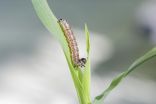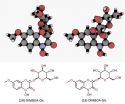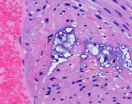(Press-News.org) This news release is available in German.
Sugars are usually known as energy storage units in plants and the insects that feed on them. But, sugars may also be part of a deadly game of tag between plant and insect according to scientists at the Max Planck Institute for Chemical Ecology. Grasses and crops such as maize attach sugars to chemical defenses called benzoxazinoids to protect themselves from being poisoned by their own protective agents. Then, when an insect starts feeding, a plant enzyme removes the sugar to deploy the active toxin. The Max Planck scientists have now discovered why this defensive strategy fails to work against Spodoptera larvae. When the researchers examined the frass of these pests − pests that cause enormous crop damage −, they found the toxin with sugar still attached. After the plant removes the sugar, the insect reattaches it but in the opposite stereochemical configuration. In contrast to the original plant compound, the new substance can no longer be cleaved by the plant enzyme to generate the toxin. Attaching the sugar in the opposite configuration turns out to be a very simple but effective detoxification strategy which explains the success of Spodoptera species. (Angewandte Chemie - International Edition, September 2014, doi: 10.1002/ange.201406643).
Plants usually defend themselves against insect feeding by producing toxins or deterrents. However, many insects have become adapted to plant defenses and can feed on plant tissues containing toxins or deterrents without the expected negative effects. Insects overcome plant defenses by the rapid excretion, sequestration or detoxification of toxic substances. Not only have such adaptations contributed to the vast diversification of insects in the course of evolution, they also support the success of agricultural pests specialized on certain crop plants that jeopardize crop yields every year.
With the abundance of maize grown throughout the world, it is not surprising that the crop has many insect pests, including larvae of the genus Spodoptera. In North and South America, the fall armyworm Spodoptera frugiperda is an important maize pest causing considerable damage. Like all cereals and other members of the grass family, maize plants defend themselves with chemistry. Leaves of young maize plants contain large amounts of a benzoxazinoid called (2R)-DIMBOA-glucoside. The plant also produces an enzyme active in caterpillar guts which cleaves DIMBOA-glucoside to release the sugar. The free DIMBOA formed as a result causes many insects to die or cease growing, but not the fall armyworm.
A group of researchers led by Daniel Giddings Vassão and Jonathan Gershenzon from the Department of Biochemistry at the Max Planck Institute for Chemical Ecology in Jena, Germany, have recently discovered a previously unknown detoxification strategy in these pest insects. Caterpillars of the fall armyworm and two other Spodoptera species deploy a gut enzyme that catalyzes the attachment of a sugar to the toxic free DIMBOA. The sugar group is reattached in a mirror-image orientation (forming a (2S)-DIMBOA-glucoside) so that the plant enzyme cannot remove it a second time. The scientists found out about this clever mechanism when they analyzed larval frass. Modern and highly sensitive mass spectrometry and nuclear magnetic resonance spectroscopy methods showed that the benzoxazinoid identified in the larval frass was no longer identical to the substance in the plant leaves.
"We were surprised that the difference between the insect metabolite and the original plant compound was simply the stereochemical configuration of one atom. The crucial change, however, is the fact that the insect metabolite is no longer reactive to the plant enzyme and the toxic DIMBOA cannot be formed any more. The elegance of such a mechanism comes from its simplicity, yet it saves the insects from being poisoned," said Felipe Wouters, who performed the experiments for his doctoral thesis at the institute, summarizing the results. Like his colleague Daniel Giddings Vassão, Felipe Wouters is from Brazil, where fall armyworm caused major losses of the maize yield before Bt maize was introduced. According to a Reuters report this summer Brazilian farmers are complaining that Bt is not protecting the plants against the fall armyworm any longer. The increasing resistance of pest insects to Bt is another reason to look deeper into the natural insect adaptations against plant defenses. "If we can better understand how much this gut enzyme has helped the fall armyworm to become such a dangerous pest on maize, we may be able to use this to our advantage by impairing this insect enzyme and restoring the full defensive potential of maize against these pests," says Daniel Giddings Vassão.
Plant-insect interactions involve very complex and dynamic metabolic processes. The importance of the three-dimensional structure of molecules and the stereospecificity of chemical reactions is often overlooked. "The chemical chirality of the compounds is the key here," explains Jonathan Gershenzon, director of the Department of Biochemistry. "These insects can teach us humans a lot about an important chemical concept, the idea that a compound and its mirror image are different even though the atoms are connected in the same way." The term "chirality" is derived from the Greek word for hand and corresponds to an anatomical principle, namely the mirror-image arrangement of our left and right hands. That two mirror molecules can have a completely different mode of action became widely known in the aftermath of the tragic effects the sedative drug Contergan had on unborn children in the early 1960s. As a drug, the chemical agent thalidomide was available in two versions, as an (S)- as well as an (R)-thalidomide. When scientists tried to clarify the fatal effects the drug had when taken by pregnant women, they found that only (S)-thalidomide caused birth defects, whereas (R)-thalidomide had the desired calming and anti-nausea effects.
The Max Planck scientists now want to identify the enzymes and the encoding genes that are responsible for the detoxification process in the fall armyworm. They also want to look for equivalent enzymes in related species and compare these. DIMBOA is only one member of the vast variety of toxic benzoxazinoids found in grasses. If the researchers can obtain a more comprehensive picture of how benzoxazinoids are metabolized in pest insects, they may be able to design better strategies to reduce pest damage. [AO]
INFORMATION:
Original Publication:
Wouters, F.C., Reichelt, M., Glauser, G., Bauer, E., Erb, M., Gershenzon, J., Vassão, D.G. (in press). Reglucosylation of the benzoxazinoid DIMBOA with inversion of stereochemical configuration is a detoxification strategy in lepidopteran herbivores. Angewandte Chemie − International Edition. DOI: 10.1002/anie.201406643
Further Information:
Daniel Giddings Vassão, Max Planck Institute for Chemical Ecology, Hans-Knöll-Straße 8, 07745 Jena, Germany. Tel. +49 3641 57-1333, E-Mail vassao@ice.mpg.de
Jonathan Gershenzon, Max Planck Institute for Chemical Ecology, Hans-Knöll-Straße 8, 07745 Jena, Germany. Tel. +49 3641 57-1300, E-Mail gershenzon@ice.mpg.de
Contact and Picture Requests:
Angela Overmeyer M.A., Max Planck Institute for Chemical Ecology, Hans-Knöll-Str. 8, 07743 Jena, +49 3641 57-2110, E-Mail overmeyer@ice.mpg.de
Download of high resolution images via http://www.ice.mpg.de/ext/735.html
Playing tag with sugars in the cornfield
Armyworms deactivate a maize chemical defense by reattaching a sugar in the opposite configuration
2014-09-25
ELSE PRESS RELEASES FROM THIS DATE:
Brazilian zoologists discovered the first obligate cave-dwelling flatworm in South America
2014-09-25
Typical cave-dwelling organisms, unpigmented and eyeless, were discovered in a karst area located in northeastern Brazil. The organisms were assigned to a new genus and species of freshwater flatworm and may constitute an oceanic relict. They represent the first obligate cave-dwelling flatworm in South America. The study was published in the open access journal ZooKeys.
Freshwater flatworms occur on a wide range of habitats, namely streams, lagoons, ponds, among others. Some species also occur in subterranean freshwater environments.
Brazil has more than 11,000 caves, ...
Water research tackles growing grassland threat: Trees
2014-09-25
MANHATTAN — Two Kansas State University biologists are studying streams to prevent tallgrass prairies from turning into shrublands and forests.
By looking at 25 years of data on the Konza Prairie Biological Station, Allison Veach, doctoral student in biology, Muncie, Indiana, and Walter Dodds, university distinguished professor of biology, are researching grassland streams and the expansion of nearby woody vegetation, such as trees and shrubs. They have found that burn intervals may predict the rate of woody vegetation expansion along streams.
Their latest research ...
Pneumonia bacterium leaves tiny lesions in the heart, study finds
2014-09-25
SAN ANTONIO (Sept. 25, 2014) — The long-observed association between pneumonia and heart failure now has more physical evidence, thanks to research in the School of Medicine at The University of Texas Health Science Center at San Antonio.
The researchers found proof that Streptococcus pneumoniae, the leading cause of community-acquired pneumonia, actually physically damages the heart. The bacterium leaves tiny lesions that researchers detected in mouse, rhesus macaque and human autopsy tissue samples.
"If you have had severe pneumonia, this finding suggests your heart ...
New study shows that yoga and meditation may help train the brain
2014-09-25
New research by biomedical engineers at the University of Minnesota shows that people who practice yoga and meditation long term can learn to control a computer with their minds faster and better than people with little or no yoga or meditation experience. The research could have major implications for treatments of people who are paralyzed or have neurodegenerative diseases.
The research is published online in TECHNOLOGY, a new scientific journal featuring cutting-edge new technologies in emerging fields of science and engineering.
In the study, researchers involved ...
Researchers uncover structure of enzyme that makes plant cellulose
2014-09-25
WEST LAFAYETTE, Ind. - Purdue researchers have discovered the structure of the enzyme that makes cellulose, a finding that could lead to easier ways of breaking down plant materials to make biofuels and other products and materials.
The research also provides the most detailed glimpse to date of the complicated process by which cellulose - the foundation of the plant cell wall and the most abundant organic compound on the planet - is produced.
"Despite the abundance of cellulose, the nitty-gritty of how it is made is still a mystery," said Nicholas Carpita, professor ...
IU-Regenstrief CHICA system improves developmental delay screening and surveillance
2014-09-25
INDIANAPOLIS -- Is my child lagging behind physically, mentally or emotionally? Should I be concerned? When should I ask our pediatrician about it? What can I do to help my child?
A new study from Indiana University School of Medicine and Regenstrief Institute researchers reports that a computerized clinical decision support system is helping parents answer such questions. The system, which they developed to automate pediatric care guidelines, significantly increased the number of children screened for developmental delay at 9, 18 and 30 months of age, as recommended ...
Study identifies gauntlet of obstacles facing migrating pronghorn in greater Yellowstone
2014-09-25
One of North America's last remaining long-distance land migrations, better known as the Path of the Pronghorn, is being threatened by a mosaic of natural gas field development, highway traffic, and fencing in the upper Green River Basin, according to the Wildlife Conservation Society. WCS scientists used a model traditionally applied to identify resource related stopovers for migrating animals in order to identify impediments to migration of pronghorn.
The long-distance travels of the fleet-footed pronghorn through this part of the Greater Yellowstone Ecosystem was the ...
New research outlines promising therapies for small cell lung cancer
2014-09-25
CLEVELAND: Two recently published studies by a research team at University Hospitals (UH) Case Medical Center Seidman Cancer Center have the potential to advance treatments for small cell lung cell cancer (SCLC). This aggressive form of lung cancer has seen no treatment advances in 30 years and "is a disease in urgent need of new drug therapies," write the study's authors.
"In small cell lung cancer, which impacts about 30-40,000 people each year in the United States, there has been no therapeutic progress and very little research," says Afshin Dowlati, MD, lead author ...
Coping techniques help patients with COPD improve mentally, physically
2014-09-25
DURHAM, N.C. -- Coaching patients with chronic obstructive pulmonary disease to manage stress, practice relaxation and participate in light exercise can boost a patient's quality of life and can even improve physical symptoms, researchers at Duke Medicine report.
In a study published online Sept. 25, 2014, in the journal Psychosomatic Medicine, Duke researchers examined how telephone-based coaching could help patients with chronic obstructive pulmonary disease, or COPD, a progressive disease that limits airflow in the lungs.
About 15 million Americans have COPD, and ...
Solar cell compound probed under pressure
2014-09-25
Washington, D.C.— Gallium arsenide, GaAs, a semiconductor composed of gallium and arsenic is well known to have physical properties that promise practical applications. In the form of nanowires and nanoparticles, it has particular potential for use in the manufacture of solar cells and optoelectronics in many of the same applications that silicon is commonly used.
But the natural semiconducting ability of GaAs requires some tuning in order to make it more desirable for use in manufacturing these types of products. New work from a team led by Carnegie's Alexander Goncharov ...
LAST 30 PRESS RELEASES:
UVA’s Jundong Li wins ICDM’S 2025 Tao Li Award for data mining, machine learning
UVA’s low-power, high-performance computer power player Mircea Stan earns National Academy of Inventors fellowship
Not playing by the rules: USU researcher explores filamentous algae dynamics in rivers
Do our body clocks influence our risk of dementia?
Anthropologists offer new evidence of bipedalism in long-debated fossil discovery
Safer receipt paper from wood
Dosage-sensitive genes suggest no whole-genome duplications in ancestral angiosperm
First ancient human herpesvirus genomes document their deep history with humans
Why Some Bacteria Survive Antibiotics and How to Stop Them - New study reveals that bacteria can survive antibiotic treatment through two fundamentally different “shutdown modes”
UCLA study links scar healing to dangerous placenta condition
CHANGE-seq-BE finds off-target changes in the genome from base editors
The Journal of Nuclear Medicine Ahead-of-Print Tip Sheet: January 2, 2026
Delayed or absent first dose of measles, mumps, and rubella vaccination
Trends in US preterm birth rates by household income and race and ethnicity
Study identifies potential biomarker linked to progression and brain inflammation in multiple sclerosis
Many mothers in Norway do not show up for postnatal check-ups
Researchers want to find out why quick clay is so unstable
Superradiant spins show teamwork at the quantum scale
Cleveland Clinic Research links tumor bacteria to immunotherapy resistance in head and neck cancer
First Editorial of 2026: Resisting AI slop
Joint ground- and space-based observations reveal Saturn-mass rogue planet
Inheritable genetic variant offers protection against blood cancer risk and progression
Pigs settled Pacific islands alongside early human voyagers
A Coral reef’s daily pulse reshapes microbes in surrounding waters
EAST Tokamak experiments exceed plasma density limit, offering new approach to fusion ignition
Groundbreaking discovery reveals Africa’s oldest cremation pyre and complex ritual practices
First breathing ‘lung-on-chip’ developed using genetically identical cells
How people moved pigs across the Pacific
Interaction of climate change and human activity and its impact on plant diversity in Qinghai-Tibet plateau
From addressing uncertainty to national strategy: an interpretation of Professor Lim Siong Guan’s views
[Press-News.org] Playing tag with sugars in the cornfieldArmyworms deactivate a maize chemical defense by reattaching a sugar in the opposite configuration








